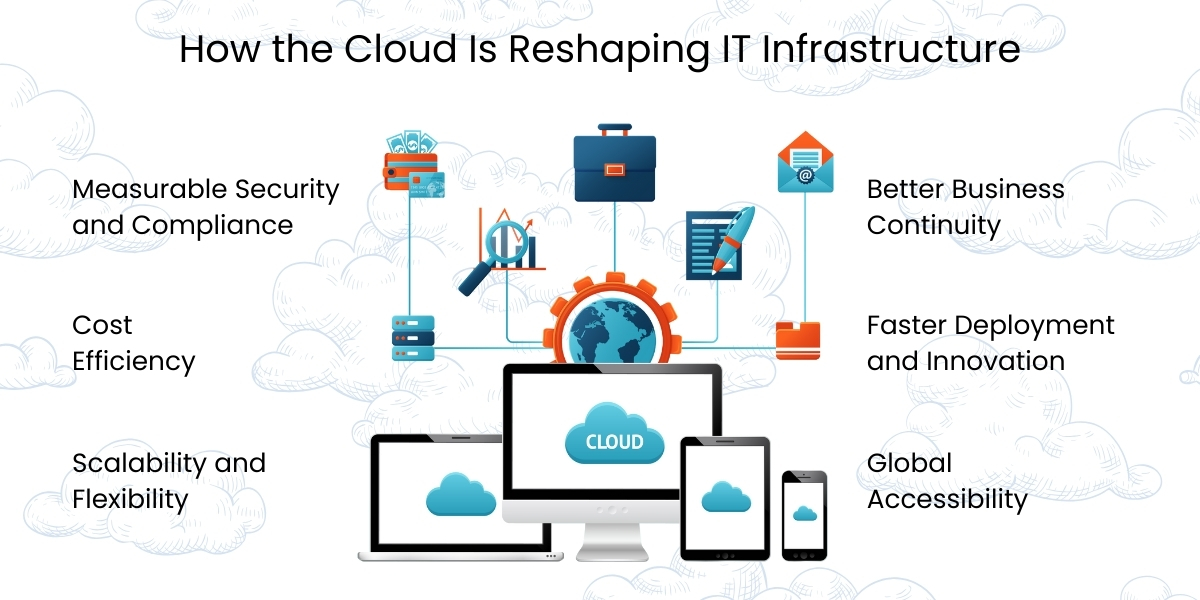The advent of cloud computing has changed the way businesses store, manage, and process data. Organizations no longer solely relied on expensive on-site servers and rigid IT infrastructure. Cloud services become an important component of modern IT infrastructure, offering scalability, flexibility, and cost effectiveness that traditional models cannot offer.
In this blog, we will take a look at how cloud computing is changing IT infrastructure so that businesses can innovate quickly and smartly.
Modernizing from Traditional to Cloud-Based IT Infrastructure
Traditional IT infrastructure requires investment in physical hardware and maintenance, along with manpower to function. As data magnitudes continued to grow, scaling became a constant challenge that , often times, lead to organizational inefficiency and downtime.
Cloud computing changed the model completely by transferring the management of infrastructure to the internet. A cloud provider such as AWS, Microsoft Azure, and Google Cloud allow businesses to access computing power, storage, and networking, all on demand, and only pay for what you use.
The Ways Cloud Computing Is Influencing IT Infrastructure
1. Scalability and Flexibility
Cloud infrastructure enables organizations to instantaneously scale up or down their resources. Whether your users are hit with a spike in seasonal traffic or you’re launching another application, you can accommodate your users’ activity without spinning up another piece of hardware.
2. Cost Efficiency
The physical data center is no longer necessary with cloud computing. The cloud is shifting your CapEx into a more predictable OpEx format. To put it simply, you only pay for what you use and waste far less than you would on physical servers.
3. Measurable Security and Compliance
The best cloud providers have a built-in arsenal of security features like encryption, firewalls, digital identity management, and compliance with security standards such as ISO, HIPAA, and GDPR, providing enterprise-level protection for sensitive data in their cloud.
4. Better Business Continuity
Cloud-based backup and disaster recovery solutions help protect data and applications so you will have little to no downtime in case of an unexpected outage. This resiliency improves your overall business continuity and disaster recovery plan.
5. Faster Deployment and Innovation
With cloud services, developers can deploy their application(s) and updates from minutes rather than days or weeks. Speed to innovation is paramount in the IoT world, and the quicker your business can bring treasure to market, the more you will win business.
6. Global Accessibility
With cloud infrastructure, your teams can have continuous access from all over the world. Thanks to common distributed data centers and global content delivery networks (CDNs), your business will be able to reach users in all the right places.
The Future of IT Infrastructure in the Cloud Revolution
As organizations advance their digital transformation efforts, the use of the cloud will continue to grow. Hybrid and multi-cloud strategies are leading the way toward a standard that embraces more control, redundancy, and flexibility in infrastructure. In addition, the growth of edge computing, along with AI-based automation of processes, will further enhance cloud-based infrastructures through increased efficiency and intelligence.
Final Thoughts
Cloud computing is not a simple upgrade of technology; cloud computing is a paradigm shift in how we think of IT Infrastructure. By adopting a cloud service-oriented model, organizations are able to attain the control, cost savings, and agility to innovate faster and more efficiently to remain competitive in a constantly evolving digital environment.
Those organizations that embrace cloud-first initiatives today are ultimately laying the groundwork for a future with unlimited potential of technology.









